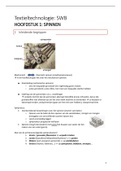Samenvatting
Summary - Tort Law
- Instelling
- Tilburg University (UVT)
This document is a clear and concise summary of all the materials covered in tort law, including definitions, relevant articles and examples of all covered subjects. Furthermore, for each jurisdiction (France, Germany & England) I made a table including the tort, the requirements and the case law/a...
[Meer zien]













